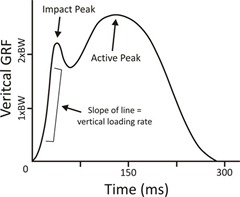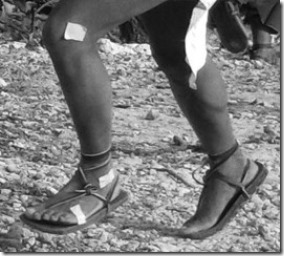 Just a quick post to announce that my first academic paper on running-related research has been published in the Journal of Sports Sciences – the title is “Foot strike patterns of recreational and sub-elite runners in a long-distance road race.” The research in this paper is based on film that seven of my former undergraduate students and I collected back in the Fall of 2009 at the Manchester City Marathon in Manchester, NH.
Just a quick post to announce that my first academic paper on running-related research has been published in the Journal of Sports Sciences – the title is “Foot strike patterns of recreational and sub-elite runners in a long-distance road race.” The research in this paper is based on film that seven of my former undergraduate students and I collected back in the Fall of 2009 at the Manchester City Marathon in Manchester, NH.
My co-authors are all alumni of Saint Anselm College, and to give them due credit, their names are Erin Higgins, Justin Kaminski, Tamara Decker, Janine Preble, Daniela Lyons, Kevin McIntyre & Adam Normile. The paper required an immense amount of often tedious frame-by-frame analysis of well over 1000 video clips or running foot-strikes, and I credit them all with the demonstrating the perseverance required to stick it out. I know what they went through as I also analyzed every single one of these clips myself! I hope this paper adds at least some useful information to the body of scientific knowledge on running form and biomechanics.
Below is the abstract, and I will probably follow up at some point with some additional thoughts. I cannot post the PDF for 12 months due to copyright restrictions, but can share via email if you are interested.
Abstract
Although the biomechanical properties of the various types of running foot strike (rearfoot, midfoot, and forefoot) have been studied extensively in the laboratory, only a few studies have attempted to quantify the frequency of running foot strike variants among runners in competitive road races. We classified the left and right foot strike patterns of 936 distance runners, most of whom would be considered of recreational or sub-elite ability, at the 10 km point of a half-marathon/marathon road race. We classified 88.9% of runners at the 10 km point as rearfoot strikers, 3.4% as midfoot strikers, 1.8% as forefoot strikers, and 5.9% of runners exhibited discrete foot strike asymmetry. Rearfoot striking was more common among our sample of mostly recreational distance runners than has been previously reported for samples of faster runners. We also compared foot strike patterns of 286 individual marathon runners between the 10 km and 32 km race locations and observed increased frequency of rearfoot striking at 32 km. A large percentage of runners switched from midfoot and forefoot foot strikes at 10 km to rearfoot strikes at 32 km. The frequency of discrete foot strike asymmetry declined from the 10 km to the 32 km location. Among marathon runners, we found no significant relationship between foot strike patterns and race times.



















Congrats!
Exciting stuff, Pete! I hope to read the full-version of this paper one day. The sample size in this study seems larger than that of most papers I’ve read in this area – I’m sure the vigorous works from you & your team would finally offer a reliable and comprehensive analysis. Now that you’ve finished your homework, perhaps it’s time for more running!
I wish, still have a book to write :)
G’day Pete, great stuff, that’s a lot of analysis and hard work! This type of practical, out of the lab research is much needed. Brian
Thanks Brian!
Shocking: Still that much heelstrikers out there?! I was thinking by now most people where adopting a running style like Chi- or Pose running. Guess I was wrong.
The race was filmed in 2009, so before the recent minimalist trend really took off. I filmed again this year to see if patterns have changed at all.
Wow! My reason for being here is that i am a young runner, and i have started a running blog from a younger perspective. Come check stop by my blog and check it out, i just started.
athleticrunning.blogspot.com
Thanks,
Athletic Running
Keep at it. Do some more in-depth stuff. Narrower focus but more depth.
thanks man for the feedback make sure to keep checking back
excellent!
Congratulations to you and your students. I can’t wait to get the full pdf, which I can download through my academic vpn account. This is a big (pardon the pun) step forward in running research. I know the difficulty and challenges in taking an idea from the thought process to the published peer reviewed article so many congrats on your patience and perseverance. Continued good luck with the book chapter as well. Saw some research that running improves brain function, so make sure to get those runs in. Your neurons will thank you.
Pete:
Congratulations to you and your colleagues on adding some very valuable and needed scientific research on the foot strike patterns of recreational runners. Your paper very clearly shows the predominance of heel striking in recreational runners and will hopefully go a long way toward giving this continued debate on proper foot strike during running a little more realism.
Thanks for all your hard work in producing this paper and please let every one of your coauthors know how much I appreciate their hard work also.
Cheers,
Kevin A. Kirby, DPM
Adjunct Associate Professor
Department of Applied Biomechanics
California School of Podiatric Medicine
Hi Pete,
I requested the pdf for your paper by email.
Was any distinction made between a foot strike that is merely shifted towards the heel (like figure 3 in your article on runners from the ’50’s) and an exaggerated heel strike, as seen in an overstriding gait?
There is an obvious difference, but I think when people see or hear the term “heel strike,” the immediate association is made to an overstride.
I’ll admit I’m a little biased towards wearing shoes for running, in large part because the arguments that we should all run with a forefoot strike, or that we need to run barefoot to correct any faulty technique have failed to convince me.
To answer your question, yes, we initially used a subjective measure of “extreme” vs. “mild” heel strike, but opted to not put it in the paper since it was very subjective and it’s hard to quantify such things as angles with precision from race video. On my original run through of the video I subjectively classified about 80% of all foot strikes as extreme heel strikes, recognizing that even within that group there is variation. I classified about 12% as mild heel strikes, which some refer to as proprioreceptive heel strikes.
I appreciate the efforts to remain objective, and you bring up a good point about the room for variation. I’m thinking of “obvious” examples of overstriding, but where do you draw the line? Thanks for the insight!
Pete, this research will make a significant contribution to the current running form discussion. Out of interest, are you aware of any similar research for trail runners? My instinct tells me that heel striking would be less prevalent in trail runners but it would be interesting to see if that assumption is correct. Cheers, Paul
There are a few studies that have looked at gait on trail surfaces, but as far as I know none from a race. I need to get on that :)
Pete, in your experience, what’s the minimum number of frames-per-second needed to analyze footstrike patterns? How much extra information is provided by a high-speed camera like the one in your lab? So much can happen immediately before footstrike that I’m wondering if a better camera provides more information. I love the advice you give to your readers to analyze their gaits, even if their only technology is a cell-phone camera.
To be really accurate, 300fps is what I like, but you could manage with one of the Casio’s that shoots at 240 and not lose much. I have a camera that does 120fps, and for playing around it’s fine, but you do lose more information. I agree – lots of stuff happens in the moments just before the foot comes down. I’m really intrigued by the movement of the foot relative to the ground prior to contact – it’s quite variable but very hard to quantify.
Many scientists just ignore that 12 month embargo and post immediately to their website. I suggest you do the same.
I’ve done that in the past I suspect, but my research on tadpole development didn’t exactly attract a lot of interest :) Trying to stick to the rules since I’m new to this Journal and general research area.
Sent from my iPad
That’s awesome! I have all the respect in the world for this as I’ve spent the last year (and six months more to come) writing for my MS thesis. So cool!
Hope you didn’t copy and paste any of my posts into it. My opinions are just my best guess or just formed out of some kind of agenda. LOL.
#BoycottNike! #DeathToMikeVick!
Reading this makes me think: Core and hip stabilization late in race following fatigue changes foot strike dynamics, for so many different reasons.
Good article!
Really nice run-themed blog…
Hi Pete,
can you email me a copy of your article please? gino_ng@ hotmail.com.
Many thanks.
Very interesting. Especially the increase in rearfoot strike at the 32 km point. One interpretation would be that it reflects a general breakdown of technique due to fatige.
I don’t know if you have split times of those who switch, but it would be interesting to know the switch is related to the pace they were running. If the switchers were running at the same or a faster pace at 32 km, this would suggest that it is not a breakdown of technique, but perhaps (also) a strategy to put some fresh muscle to work when the calf muscles are spent.
BTW: Were there any switches the other way around, from rear foot at 10 km to forefoot at 32 km?
I guess further research is needed, as is undoubtedly among the conclusions of the article ;)
I think there werea few who did switch the other way, but very rare. I do have split times, so it would be possible to look at that. I’m processing a bunch of stride timing data from the same video set – slow work but one of the things I’m interested in is how split times might relate to changes in stance vs. flight time at the two race points.
Sent from my iPad
Ah! Checking if ‘reduce ground contact’ makes sense for the recreational runner. That is an interesting angle. I am very curious. Keep up the good work.
Actually, increasing ground contact will increase efficiency and reduce tissue stress if it reduces vertical oscillation. So, my prediction is that those with too much air time relative to contact may have more significant positive splits.
So the hypothesis is: relative air time equals tiring. That’s a good one. From first principles, that seems pretty plausible. See if reality bears that out.